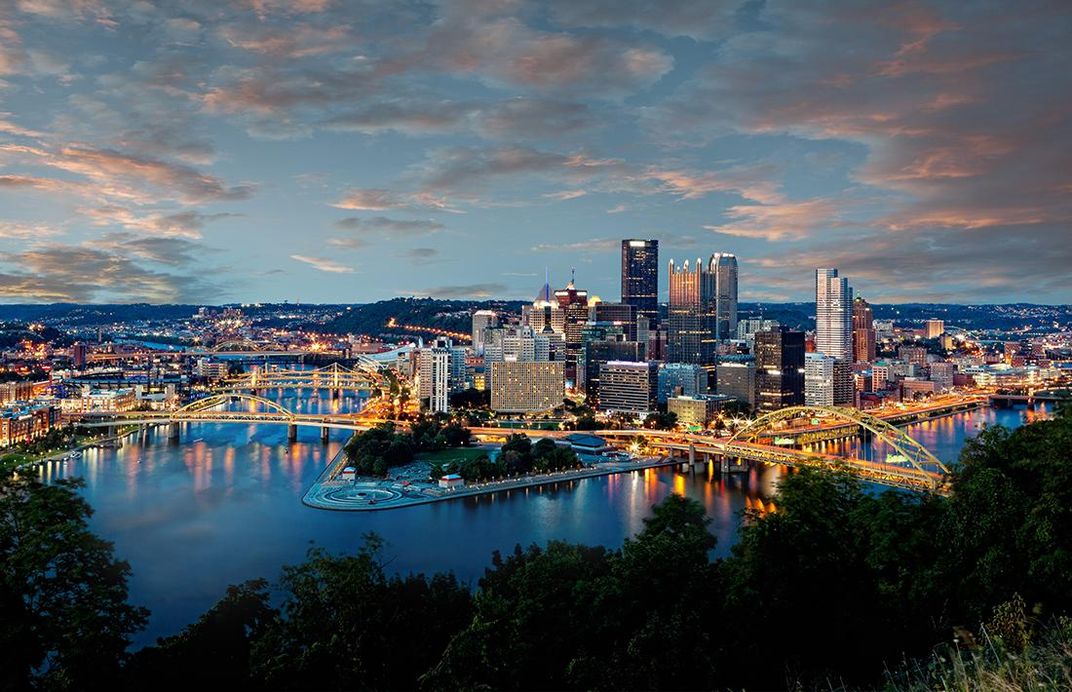Celebrating Pittsburgh, the City Behind Pro Football, Big Macs and the Polio Vaccine
The Pennsylvanian city had more lives than a cat and thrives as a hub of innovation

Pittsburghers, locals say, are proud in a quiet sort of way. For that reason, outsiders may not realize that the western Pennsylvania city is responsible for everything from banana splits to the emoticon. For years—16,000, to be exact—Pittsburgh has served as a hub for innovation across industries as varied as sports, weaponry, board games and condiments.
The Senator John Heinz History Center, a Smithsonian Affiliate museum situated along the Allegheny River in downtown Pittsburgh, is now celebrating that history in a large-scale exhibition, “Pittsburgh: A Tradition of Innovation,” on view long-term. The two-floor show moves chronologically, beginning with descriptions of the earliest Pittsburghers fashioning tools at the Meadowcroft Rockshelter thousands of years ago, and moving all the way to the recent developments in science and medicine that have come out of the city. The exhibition also features life-size figures of Mr. Rogers, Rosie the Riveter and Andrew Carnegie, all of whom were born or lived in the Pittsburgh area.
Among the long list of innovations to come from the city and its hometown heroes are ground coffee, canons and warships, labor unions, aluminum, professional football, ketchup, the Ferris wheel, banana splits, gas stations, movie theaters, numbers on sports jerseys, road maps, bingo, commercial radio broadcasting, bebop music, pull tabs on cans, the Big Mac, emoticons and, most notably, the polio vaccine.
How is it that the city, currently home to 305,000 people, has been so influential? One reason is geographic. “All roads lead in and out of Pittsburgh,” says Lauren Uhl, a Heinz Center project manager and one of the exhibition curators. Because of its location, Uhl says, it became a "gateway to the west" for easterners venturing into the frontier. Later, the city attracted industry because of its crucial position near the Ohio, Allegheny and Monongahela rivers.
Another reason is ideological. “It doesn’t happen here by chance. There is a mindset that is open to ideas,” Heinz Museum Division Director Anne Madarasz says, “a community that’s open to creativity and willing to try and fail, and try again.”
The city has continually reinvented itself. At the turn of the 20th century, Pittsburgh was home to thriving glassblowing and iron industries. Over time, that money stayed local, but found its way into other types of business. “The industrial wealth that was generated here stayed here, and that wealth was reinvested in this re-imagination of the city,” Madarasz says.
That’s not to say Pittsburgh has had it easy. “The city’s history has been marked by challenges,” says Rob Ruck, a history professor at the University of Pittsburgh. At its peak in 1950, according to The New York Times, the city’s population was 677,000, twice the present-day number. Still, it has fared better than some other Rust Belt cities.
“It’s an unpretentious city of people who work hard and play harder,” says Ruck, who has lived in Pittsburgh for more than 50 years.
“I’m a real convert,” adds Uhl, originally from Cleveland. “People…really deeply love the city and care about it and that gives Pittsburgh a certain personality," she says. "It’s a very gracious city.”
“Pittsburgh: A Tradition of Innovation,” is on view long-term at the Senator John Heinz History Center in Pittsburgh, Pennsylvania. Admission to the museum is free on Museum Day, September 27. Tickets are available here. Smithsonian Media's Museum Day Live! offers free admission to more than 1,000 museums across the country. Smithsonian Affiliations is a national outreach program that develops long-term, collaborative partnerships with museums, educational and cultural organizations to enrich communities with Smithsonian resources.
/https://tf-cmsv2-smithsonianmag-media.s3.amazonaws.com/accounts/headshot/MAx2.jpg)
/https://tf-cmsv2-smithsonianmag-media.s3.amazonaws.com/filer/0e/15/0e15a245-06c0-4780-a440-47fc705e9cc5/21_jeepinexhibit_1800x1200.jpg)
/https://tf-cmsv2-smithsonianmag-media.s3.amazonaws.com/filer/75/65/75658156-eaf7-4913-86ac-cbf242d12dbe/history_center_rosie_the_riveter.jpg)
/https://tf-cmsv2-smithsonianmag-media.s3.amazonaws.com/filer/39/c6/39c6c6ed-4f1c-425d-b8e2-2cf468c4c251/ferriswheel.jpg)
/https://tf-cmsv2-smithsonianmag-media.s3.amazonaws.com/filer/2d/e5/2de5eaaa-8c10-4847-9170-98670520f42c/mister_rogers.jpg)



/https://tf-cmsv2-smithsonianmag-media.s3.amazonaws.com/accounts/headshot/MAx2.jpg)